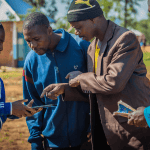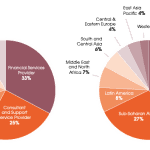Revisiting our Assumptions About Digital Financial Inclusion: Three Unexpected Findings from BFA’s FIBR Project
BFA is about to conclude our FIBR (Financial Inclusion on Business Runways) Project, an innovative R&D initiative which sought to demonstrate how smartphones can accelerate and deepen financial inclusion in developing countries. When we launched the FIBR Project in 2015, we outlined a set of assumptions about how increased connectivity and digitization would create “business runways for financial inclusion” for small businesses in Africa, helping to accelerate the ongoing process toward greater inclusion. We assumed that two dynamics would lead these small businesses to become digitally included: 1) Expanding smartphone access would connect them to increasingly available data channels, and 2) newly digitized records and processes would enable them to access digital financial services.
As the FIBR Project concludes, we’re reflecting on the past four years of work, and considering the ways in which these dynamics have unfolded in the real world. Here are three lessons we’ve learned in the process.
Data connectivity has increased, but use cases for business remain limited to mobile money
Our first assumption in the project was foundational: that the spread of data connectivity would continue through smartphones, creating the prevailing tailwind to enable the other steps toward greater digital inclusion. GSMA had forecast that smartphones as a percentage of mobile connections in sub-Saharan Africa would rise from under 20% in 2014 to over 50% by 2020. So far, this forecast appears to be on track: 39% of African mobile subscribers had smartphones at the end of 2018, and the GSMA predicts that this will rise to two-thirds by 2025.
Of course, having a smartphone is not the same as actually using its for productive purposes. Our original FIBR white paper reported on the costs of mobile data in 2015 in the two envisaged FIBR markets, Ghana and Tanzania, and flagged the cost of mobile data as a potential impediment to smartphone usage. In 2015, the Alliance for Affordable Internet started tracking the cost of 1 GB of data as a percentage of income per capita annually across a range of developing countries. Their 2018 report showed that this cost had fallen in Africa as a whole, although the average remained well above their recommended “2 for 1” level (i.e. a cost of 2% or less for 1 GB of data).
Our assumption about how connectivity would make digitization more likely also included the view that it would enhance access to digital payment systems through which customers can make or receive payments. In this area, there was quite substantial progress between 2014 and 2017. The World Bank’s Global Findex Survey reports that the percentage of adults with a payment account in sub-Saharan Africa rose by almost a third to reach 43% in 2017.
More importantly than simply having an account, the percentage of adults who actually made or received a digital payment rose from just over a quarter to over a third during this three-year period. Of course, in Africa, most of this took place using mobile money; according to the GSMA’s 2018 State of the Industry Report (SOTIR), the number of active mobile money accounts in sub-Saharan Africa rose from 84 million to 146 million between 2015 and 2018. Over a tenth of payments in 2018 by value were mobile money payments made to merchants, almost tripling the 4.1% of payments reported in 2015. However, the 2018 SOTIR report remarks that, despite growing use of smartphones to transact via mobile money worldwide, 90% of mobile transactions in Africa were still done using USSD and not through a smartphone app.
While these trends are in general positive for digital inclusion, they suggest that internet connectivity alone does not lead to usage for business or work. The Economist magazine pointed out in a June 2019 article that the dominant use cases for people newly connected to the internet are for entertainment and social media, and quoted a researcher who said that “play dominates work, and leisure overtakes labor.”
Digitization has been valuable but has not yet unlocked access to financial services in Africa
The original FIBR white paper recognized that there were numerous barriers to digitizing business records, including the costs of adopting new processes, and concerns about getting onto the radar of taxation agencies and other regulatory authorities. However, we hypothesized that new smartphone apps would require less time and effort for adoption, and that the allure of more and better formal financial services would tip small businesses towards digitization. The FIBR team also envisioned its partners using trusted nodes in the community to help encourage digitization.
In all, FIBR was able to support experimentation with a variety of apps to help small merchants keep track of their stock and generate digital financial records, and we have seen how these apps can help business owners. However, it has proven harder to get incumbent formal lenders like banks to lend against the records generated by these new digital sources.
New platforms and lenders are shaping the market in unanticipated ways
In our focus countries, digitization did not lead to the offering of new financial services to the extent we had hoped. However, experiences outside Africa show that new kinds of lenders are increasingly willing and able to utilize data from small businesses, especially when the lender controls and can verify the businesses’ revenue data. For example, e-commerce companies can easily check the revenue data for the small merchants on their platforms: That’s the case with Amazon, which started lending to its merchants in the U.S. in 2011, and has reportedly lent over $1 billion per year over the last three years. This form of linkage for finance has gone even further and faster in China, where a chapter in a recent Bank for International Settlements (BIS) report shows that China boasts the highest levels of fintech (non-bank) credit per capita—more than three times the levels in the U.K., U.S. or Korea.
Among Chinese fintech companies, Ant Financial has been a leader. Ant started as the payment arm of Chinese e-commerce giant Alibaba. It obtained a license to set up a bank in 2015 and its growth soared: Little more than three years later, it reported having some 6 million SME clients and a total loan book of close to $120 billion. The same BIS report estimated that big tech companies like Ant Financial make up around a third of all fintech credit in China – a much higher level than in the U.S. or U.K., although not higher than in Korea.
The success of these big tech companies in financial services suggests that they are “generative,” meaning that they offer not just useful services, but also the chance for small businesses to generate an income. This role adds an additional layer to the initial hypothesis we outlined in the second FIBR white paper in 2017. While we originally hypothesized that access to financial services would motivate digitization, we are finding that access to income opportunities has actually been the key incentive for digitization. The opportunity to generate more income has likely been the core incentive that has motivated so many small businesses in China (and increasingly elsewhere) to get online and overcome the barriers to adoption. The links to financial services are a later benefit, especially if non-banks are allowed to lend on the basis of trustworthy data about new revenue, as we originally hypothesized.
Africa’s progress with e-commerce to date has been far slower than China’s – indeed, the leading African e-commerce platform, Jumia, was only founded in 2012. At the time FIBR started, Jumia had just expanded from its home base of Nigeria into other African markets, including the two FIBR reference countries, Ghana and Tanzania. While sales grew fast and fueled Jumia’s successful public IPO in April 2019, its coverage of merchants (80,000 active) is still small relative to the number of small businesses across Africa. There remains much untapped generative potential in digital commerce across the continent.
But though connections to financial services via e-commerce platforms have been slow to take place in Africa, online gig economies are more quickly facilitating these linkages. The rise of gig work in the U.S. and elsewhere dates back to the establishment of bellwether gig platforms like Uber (2009) and TaskRabbit (2008), and has connected millions of individuals to work opportunities. At the time FIBR started, this type of work was barely present in Africa—Uber launched in South Africa, its first presence in Africa, in 2013. However, there are now many gig platforms across the continent: In 2018, Insight2Impact’s digital platforms database recorded 51 platforms in the personal and professional services category across Africa. Following the dynamic FIBR originally posited, as these workers have connected to online gig platforms, their records of work are being digitized and their access to financial services is growing. This growing segment of workers, who we have elsewhere called iWorkers, are becoming eligible for enhanced financial services and even portable benefits.
Four years on, FIBR’s starting assumptions about the implications of expanding connectivity still hold in general, even though digital financial inclusion is increasingly being driven both by new players and by new opportunities for people to earn incomes that we did not anticipate back in 2015. The next generation of action research beyond FIBR will have to consider how best to engage these players and make best use of the opportunities available.
David Porteous is the Founder and Chair of BFA (a NextBillion partner).
Photo courtesy of EmilianDanaila.
Homepage photo via Unsplash.
- Categories
- Finance



